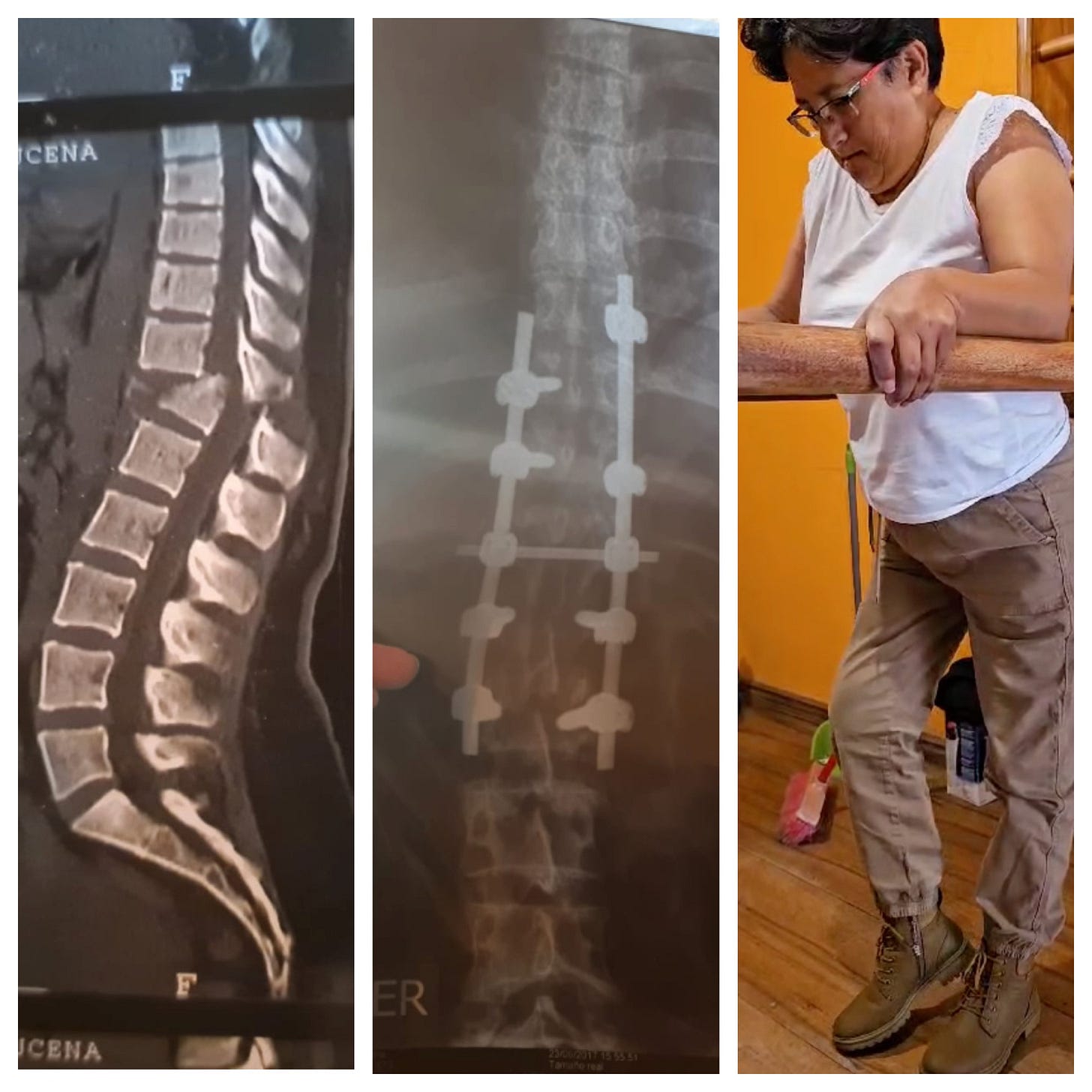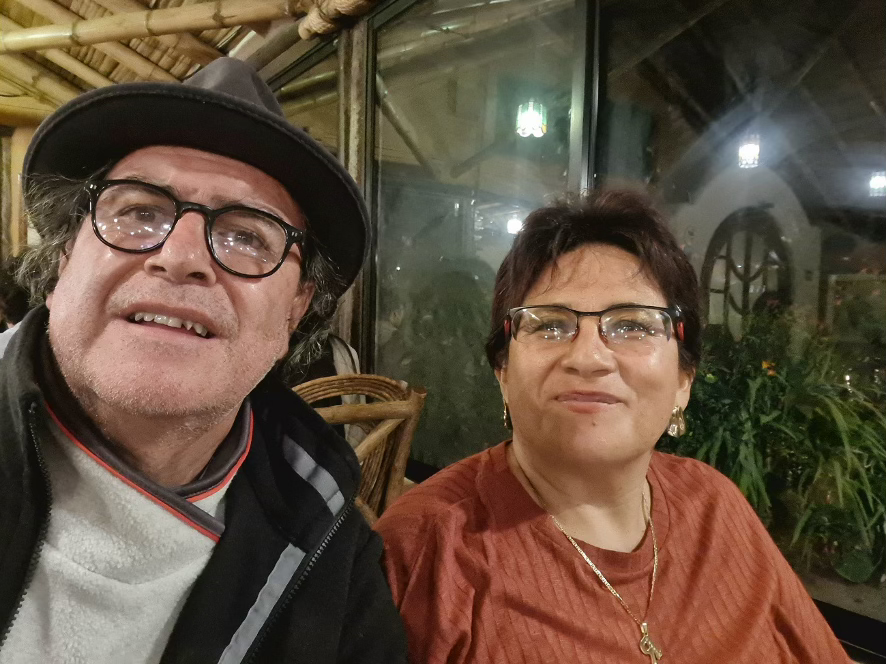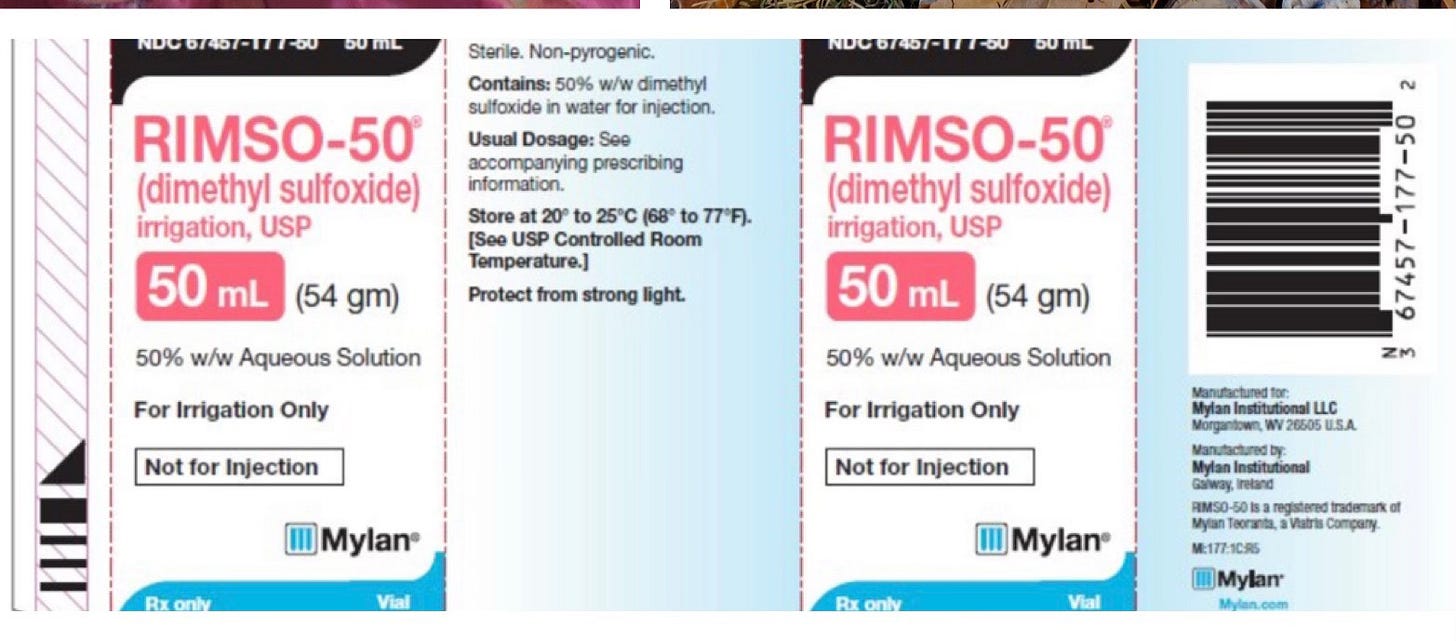Like Penicillin, ‘Miraculous’ DMSO Could Change the Lives of Afflicted Millions
The FDA long ago buried dimethyl sulfoxide, but a crusading physician and the medical freedom movement may resurrect it for stroke, paralysis, chronic pain, and more.

In 2017, Rosa Azucena Aguirre, fifty-one years old, fell through a skylight and landed one floor below and face up on concrete. Her X-rays show a horrifically mangled lower spine that took some eight hours of surgery to align. Mrs. Aguirre, who lives in Quito, Ecuador, was left paralyzed from the waist down.
While most traumatic spine breaks are treated with high-dose steroids, Mrs. Aguirre was given a safe, natural substance virtually unused in the United States: dimethyl sulfoxide, or DMSO.
“I was told after surgery that Rosita would never walk again,” her husband Juan wrote to me in Spanish. “I accepted it, and I got stronger.” But in the course of five months of intravenous therapy, he and her treating doctor, Lance Grindle, watched as remarkable changes occurred in Mrs. Aguirre’s lifeless legs.
A half-century after it was lost to medicine, DMSO may yet take its rightful place in the medicine cabinet and maybe even in the pantheon of medical cures.
Check PubMed for DMSO, and more than 39,000 studies come up, many of them documenting efficacy in treating dozens of conditions in laboratory animals and people. Then ask why your doctor doesn’t even know about DMSO—and why the FDA long ago all but banished it from clinical use.
A seasoned physician with a fierce moral compass, who writes under the Substack pseudonym A Midwestern Doctor, AMD is determined to change that—part of a mission to resuscitate proven and potential cures that have been lost to our pharma-dominated medical culture.
First up is DMSO, a drug and over-the-counter supplement that can be injected, delivered intravenously, taken orally, or applied topically—where it quickly moves through the skin to the circulatory and other systems. As natural as penicillin, DMSO can be found in some vegetables and is a smelly, oily byproduct of wood pulp processing.
“Whenever the occasional miracle drug comes out that works too well with a wide range of applications,” AMD wrote in the second DMSO post last September, “it is inevitably consigned to the dustbin of history regardless of the data put forward for it.”
AMD’s nine articles—amounting to 399 printed pages—have alone drawn more than two million views and have been boosted by other influencers—Dr. Pierre Kory, Dr. Joseph Mercola, and podcaster Joe Rogan—earning them bona fide viral status. The articles have drawn ten thousand comments, including sometimes-startling testimonials of spinal injury reversed, Parkinson’s improved, and mundane reports of urination restored, and hemorrhoids, dental disease, and skin conditions vanquished.
Published studies since the 1960s suggest a range of possibilities for DMSO that have not been fully realized. Although many studies are old, small (though not all), lack control groups, and involve laboratory animals as well as people, their sheer number suggest this forgotten medicine deserves revival.
Together, they show DMSO quells or eliminates pain, heals wounds and musculoskeletal injuries, prevents scarring, treats traumatic brain injury and its destructive swelling, treats many skin conditions like chronic skin ulcers; alleviates or cures a range of autoimmune and internal organ disorders including rheumatoid arthritis, multiple sclerosis, ulcerative colitis, myasthenia gravis, and pancreatitis, and helps neurological conditions such as headaches, circulatory disorders, concussion-associated brain and behavioral issues, and perhaps even Alzheimer’s and Parkinson’s disease.
A 2023 review of skin uses alone concluded, “DMSO has shown promise in the off-label treatment of basal cell carcinoma, pressure ulcers, scleroderma, herpes simplex, cutaneous fungal infections, and amyloidosis.” Another review, among several, found it safe with adverse reactions that were “mostly transient and mild.”
And yet, after decades of promising research, the FDA anointed interstitial cystitis in 1978 as the only condition for which DMSO was, and still is, approved. (Of note, the FDA press office could offer no guidance for this article on its use, approved or not.) In a spot-on critique, AMD attributes the long-ago stonewalling of DMSO to FDA’s embrace of the “scientific supremacy of randomized controlled trials.”
Who, after all, would pay millions to test a cheap drug with the potential, as shown in a famous 60 Minutes segment, to help a once-paralyzed woman step slowly with a walker; keep an injured pro-football player in the game; and resolve a woman’s two-year excruciating whiplash injury?
“I think if I would have said it was good for a sprained ankle, but only if the ankle sprain were on the left side,” DMSO’s pioneer, Dr. Stanley Jacob, told Mike Wallace in 1980, “DMSO maybe might be approved today.”
To kill DMSO, AMD wrote, FDA repeatedly cited the anaphylactic death of a woman in a research study who continued to take DMSO after having an allergic reaction, as well as eye changes in dogs that reversed after treatment and were of little consequence in numerous other studies.
“Nobody’s died from using DMSO,” an FDA official, Richard Kraut, said years later in the 60 Minutes interview. “It’s a relatively safe drug as [far as] drugs go.”

A Child Blossoms
Betsy is a vibrant two-year-old with Down syndrome, “a magical little girl, a precious soul,” according to her mother. Last fall, her parents Ian and Kristen Malcolm tried DMSO for their delayed but thriving child, first on her skin to make sure it was safe and then in her bottle with milk.
Within three weeks, they saw change. Betsy started crawling. She was more engaged in language and more active. After two months, she sat up. Since then, her vocabulary has grown, and, though still raw, Kristen said, “She looks like she is speaking with intention.”
Betsy also was given selenium, magnesium, and other new vitamins, so who knows? Her parents are delighted. “It feels like it was a tipping point,” Ian said, “and now things are speeding up.”
In 1975, two clinical trials documented DMSO’s potential for children like Betsy. In one from Chile, fifteen children under three years old received two essential amino acids and DMSO; Betsy was incidentally also taking amino acids. Known to cross the blood-brain barrier, DMSO is thought in the Chilean study to have helped the amino acids activate neuronal function that is suppressed in Down syndrome children.
The progress of the children who received DMSO compared to untreated children was clear: “Greater receptiveness to outside stimuli…greater interest in the surrounding environment…improved muscular tonus…muscular coordination and statics also presented significant improvement, which in turn resulted in better sociability and less dependency.”
The studies weren’t perfect. DMSO’s odor, for one, makes it difficult to guarantee unbiased conclusions, even when researchers aren’t told who is treated and who isn’t.
“In Chile, they are still offering to treat Downs with DMSO,” said a doctor in Ecuador who has used it for thirteen years. “Still doing it probably means that it works.”
Stopping Stroke
In 2023, strokes—officially listed as cerebrovascular disease—killed 162,000 Americans, the fourth leading cause of death. But what if there was an effective, readily available drug or supplement to sharply curb that? There likely is one—hiding in plain sight in the medical literature.
As early as 1976, a study of post-stroke rhesus monkeys showed DMSO afforded “significant protection from the severe neurological deficits” compared to “dexamethasone and no-treatment controls.” In following years, animal studies showed DMSO could curb damage when blood supply was cut off to the brain. And, in 2002, a pilot study of people given intravenous DMSO at stroke onset, showed seven of eleven were “improved or markedly improved” up to six months later—triple the improvement of a control group.
AMD and colleagues have long used DMSO against stroke. “We feel it’s a crime it’s not the standard of care,” AMD told me. “So many could be spared from lifelong disability with it.”
DMSO works in both ischemic (blood-clot caused) and hemorrhagic (brain-bleed related) stroke, obviating the need to wait for a CT scan before initiating treatment. AMD believes DMSO should be in every ambulance, where it could be given intravenously to stroke as well as spinal cord injury patients.
Lacking that, there are alternatives. “In the case of topically, I put it over the arteries that feed the part of the brain affected by the stroke,” AMD wrote to me. “I made up the latter approach and I have not seen any data on if this ‘works’ but it seems logically plausible and has worked when I tried it (although IV does more).”
A similar protocol to reverse a suspected stroke, from naturopathic doctor Amandha Vollmer, suggests rubbing DMSO on the neck, head, shoulders and spine, while consuming small amounts in water periodically.
“Given soon after a stroke, DMSO can dissolve the clot that causes the stroke, restoring circulation and avoiding paralysis,” Vollmer writes. “A substance that can stop a stroke as it’s happening is something many might want in their home medicine chest.”
Decades ago, Dr. Jacob gave all his patients a “stroke kit” with a DMSO vial and a syringe. The instructions were provided by his son, Jeff Jacob. They read:
“In the event of a stroke, the entire content of the vial is to be injected into the buttocks as soon as possible. The sooner the better. Do not waste time.”

Feeling Restored
When Rosa Aguirre severed her spinal column, the DMSO she received helped curb the catastrophic swelling and inflammation that makes healing from such trauma all but impossible.
Before treatment, “There was no feeling from the waist down, none whatsoever,” said Dr. Grindle, who grew up in California and practices in Ecuador. After DMSO, “she had sensitivity down to her feet.”
Grindle’s first observation was encouraging. Mrs. Aguirre did not—and never did—develop skin ulcers, mostly likely because of the innervation of small capillaries under the skin as DMSO reached bundles of nerves on the outside of the spinal column. This, in itself, Grindle said, was “an achievement.” But there was more.
“When I started, we came up with the idea: whoever attended her would mark a line on her skin between feeling and not feeling,” he explained in a telephone interview. “The little lines just walked down her leg, like a few millimeters or so every day.”
Grindle wrote in an email, “I would speculate here (this is just speculation) that the DMSO, during the months of treatment, went on to not only limit edema and inflammation but later on intervened in actually repairing the cells, starting with the outer layers of the damaged nerve bundle. DMSO can repair cells.”
In a recent video provided by her husband, Mrs. Aguirre, now fifty-seven, gingerly picks up one foot, then the other, as she grasps parallel bars in a therapy session. She drives with mechanical aids and can transfer to a wheelchair. She is “working on” using a walker, her husband said. “What Rosita has achieved now is fantastic because she is independent,” he wrote in an email. “I believe that efforts should be made to popularize” DMSO.
Her recovery was limited, Grindle believes, by a five-day delay in administering the 50 grams of DMSO that she received daily for four months, then intermittently for about six weeks. If not for that, “I would venture to say she could be walking without assistance now,” Grindle said. “Injury isn’t the thing. It’s the swelling of the place where the spinal trauma occurred. Not receiving the blood supply causes most of the sequelae.”
A 2022 study of rabbits with spinal injury showed “considerable neuroprotective effect of DMSO on neurological, biochemical, and histopathological analyses.” Tragically, that conclusion came decades after a 1975 review of the medical literature showed DMSO “highly desirable as an agent used for treatment of head or spinal cord trauma.”
Meanwhile, the steroids almost always used in such cases, a 2022 review concluded, have been shown in meta-analyses to have “no effect on neurological improvement.”
In other words, they fail.

Bucking the Dogma
For anyone who followed the FDA’s vilification of off-label covid drugs like ivermectin and hydroxychloroquine—most surely to enable emergency use authorization for mRNA vaccines—DMSO denial is no surprise. In something akin to karma, the actions of the agency, along with the White House and Big Pharma, have spawned a movement to liberate cheap, effective, and off-patent drugs. Witness AMD and legions of medical freedom followers.
That movement, and the doctors who started it by bucking covid dogma, may have helped Make America Healthy Again become a decisive campaign issue. One of Robert F. Kennedy’s goals, as the newly approved Secretary of Health and Human Services, is to put proven, off-patent medications to good use.
Dr. James Miller is a surgeon-turned-family-practitioner—a consequence of his pandemic opinions—who discovered DMSO through AMD’s articles, starting last September. He has found “phenomenal success,” he told me, in treating migraines, neurological issues after stroke, and skin rashes. Starting slowly and often using only topically, Miller has seen DMSO partially clear Bell’s palsy (the patient mistakenly limited application to one facial area), and nerve pain in a patient with chronic Lyme disease.
In one case, a lupus patient first took DMSO topically, then orally. “Lupus went away after three weeks, and isn’t taken orally anymore,” he said. A patient with a kidney stone—and had had difficult surgery for one before—started rubbing DMSO on his back, then taking it orally. “Last I heard, he was perfect,” Miller said.
“Not 100 percent of my patients with late stage hip arthritis are walking without a cane in a week,” Miller said. “But some are.” These positive outcomes are “humbling” and have made him cautious of overusing DMSO, potentially the proverbial hammer: “You start seeing nails everywhere.”
Miller is the rare physician with the independence to practice as his research and experience dictate. But his kind is rare, and his patients, fortunate.
Other people, meantime, struggle with how to use it, a process that can involve daunting research. (I, for one, tried DMSO for tinnitus but the one published study involved an ear spray mixed with anti-inflammatory and vasodilatory drugs along with daily injections. The DMSO drops that I applied to my ears did not work, which is why we need medical guidance and doctors willing to treat.)
On a Crusade
A Midwestern Doctor is one of those rare gifts of a horribly mismanaged pandemic. What began in 2020 as an effort to use existing drugs to treat Covid-19 has morphed, especially as vaccines proved harmful, into something far more consequential: “A once-in-a-lifetime opportunity to expose the dangers of the pharmaceutical industry,” said AMD.
Not one to simply criticize, AMD wants to offer alternatives—DMSO is one—that may effectively and inexpensively alleviate and prevent human suffering.
“All the DMSO stuff,” AMD wrote in an email, “is part of a broader push I’m making to fix the healthcare system.” That means taking on pharmaceutical “scams” like statins, osteoporosis, and acid reflux drugs, antidepressants and blood pressure medications; and mismanaged conditions like skin cancer and spinal pain with mainstream advice (avoid sun) and treatments (painkillers) that make matters worse.
AMD’s language sometimes borders on hyperbole in describing DMSO’s possibilities: “miraculous…revolutionizes care…remarkably safe…remarkably effective…lifesaving.”
What is certain is that DMSO deserves its rightful place in medicine.
“My father is smiling in Heaven,” Stanley Jacob’s son Jeff wrote in an email, “knowing that DMSO has a new voice and has not been forgotten.”




